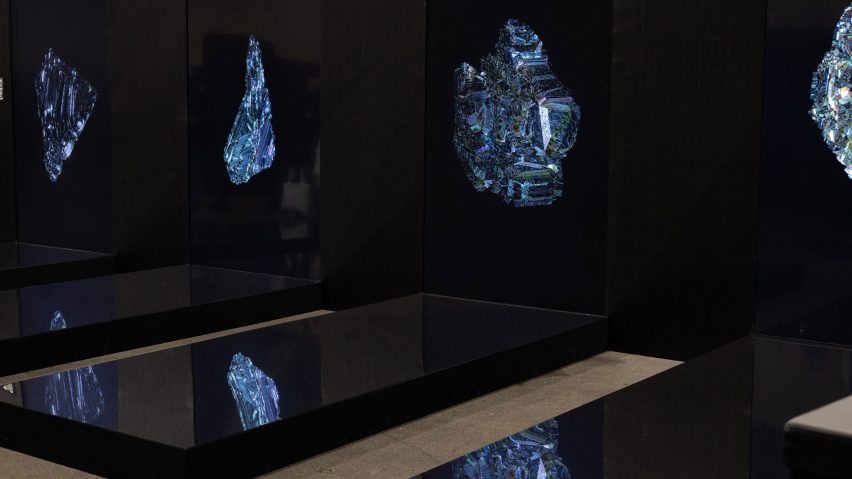Promotion: architect Alper Derinboğaz has used artificial intelligence and research data to create Neogene, a series of 3D artworks created to resemble the mineral bismuth.
The pieces were created for digital art platform Technological Art Experience (TAEX), which described the Neogene collection as "3D artefacts, generated using data morphosis methodology, based on simulations of geological formations from prehistoric times."
The first digital artworks in the Neogene collection are called White Mass and were "re-morphed from bismuth" – a mineral that has existed since the earliest life on Earth.
They represent Derinboğaz' experimentation with artificial intelligence techniques, which he thinks we will eventually be able to use to create physical as well as digital objects.
"We have used 2D AI technologies to project into 3D AI objects," he told Dezeen. "What we will mostly see online is the 2D AI, which actually is a simulation of the representation. I am interested in how we could potentially create real objects through AI."
The Neogene collection comprises 10 3D artworks depicting iridescent Bismuth crystals from different angles.
"Each artefact in the collection has a unique pairing of generated 3D forms and earth-based material qualities," TAEX said.
Derinboğaz, who is the founder of architecture studio Salon, said he created the collection as a continuation of his earlier work.
"The origin of the Neogene collection is rooted in my Leisure Institute studio at Pratt GAUD Architecture," he said. "We were seeking ways to recreate 3D morphologies in the digital realm with AI technologies based on scientific research."
The Neogene collection aims to widen our understanding of architecture and "perception of time".
"I believe we have a generic foundation of imagining an architectural form mostly based on a Western perspective – such as antique typologies, greek temples, primitive hut or even Villa Savoye – whereas this range of architecture history only represents a tiny fraction of what humanity has experienced as architecture," Derinboğaz explained.
"Together with this project, we are seeking foundational ways to simulate geographical artefacts in a Cartesian world, which I believe are easy to translate into physicality."
The artworks were launched at the third edition of NFT Paris – a conference that calls itself the world's largest web3 event – and can be purchased using the cryptocurrency Ethereum.
Derinboğaz believes now is a good time to revisit non-fungible tokens (NFTs) since the boom for them has passed.
"Innovation is an extremely powerful drive," he said. "And I feel responsible to set better examples for what meaning it might have for us."
"The NFT boom is over so I think it is worth a revisit," he added. "NFT feels like a gate to connect both the physical and digital world. And I have been very interested in that since the Augmented Structures project that I did with Refik Anadol in 2011."
The Neogene collection comprises 10 3D artworks
TAEX chief operating officer Vlada One praised the platform's partnership with Derinboğaz and emphasised the power of NFTs and the blockchain system to disseminate knowledge.
"As a science and a medium, architecture appears to its user as something very solid, that would certainly outlive many a human lifespan, yet it is quite unmovable," said One. "Through blockchain, architecture’s power for social and environmental speculation emerges as liquid knowledge, easily transferable worldwide."
"The synergy fostered by this partnership propels us towards visibility and transparency in the inner mechanisms of architectural practices, especially in the nuanced integration of data, like in Neogene."
Derinboğaz has previously designed Ecotone, a set of partially open-air offices for Yıldız Technical University in Istanbul that were created to be "pandemic resistant".
Partnership content
This article was written by Dezeen for TAEX as part of a partnership. Find out more about Dezeen partnership content here.

